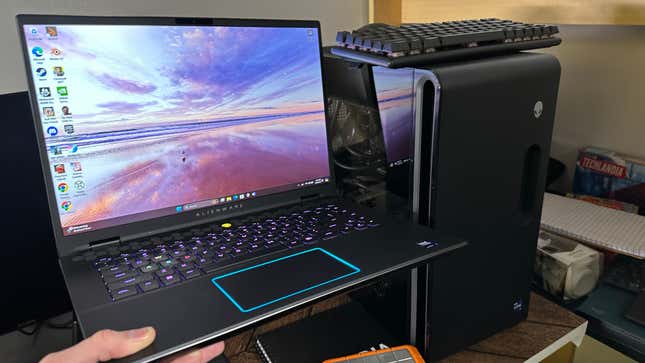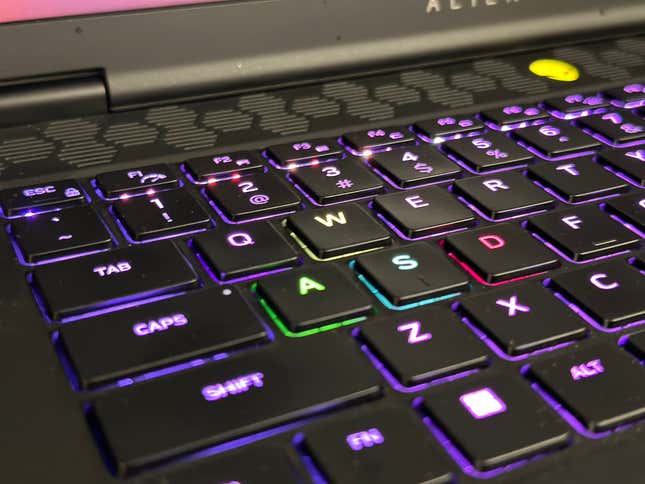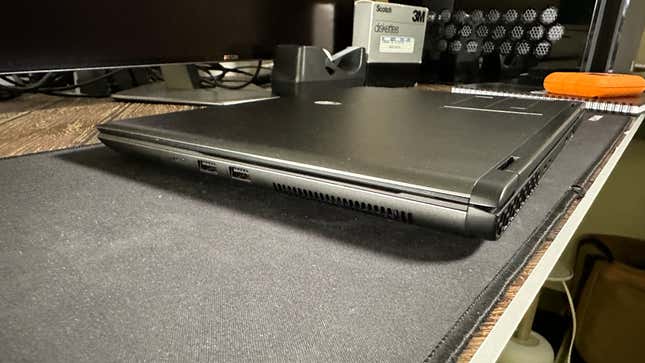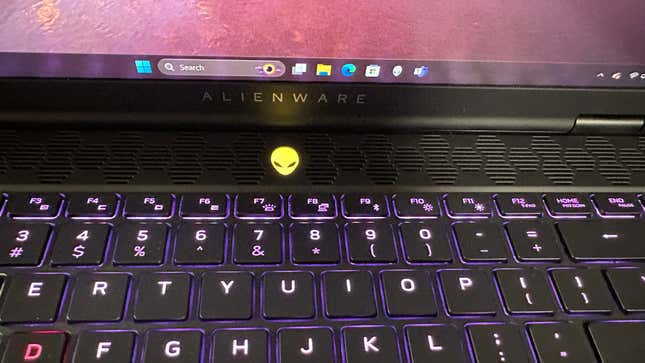
Alienware m16 R2
It has good performance for its price, but it's also a nicely portable 16-inch gaming laptop with the added benefit of being extremely usable.
Pros
Cons
I can’t start talking about Alienware’s redesigned m16 gaming laptop, the R2, without first telling you straight up why I like this laptop as much as I do. I don’t like it because of its performance, even if it’s fairly good for its mid-range price point. It’s not the 240 Hz display, which is also nice-looking but not spectacular. It’s not even the keyboard, which I find far better than most laptops of this kind but not exactly best-in-class for on-the-go gaming. It’s the palm rest. The palm rest is my favorite part of the Alienware m16 R2. It’s comfy without being plush and matte without feeling slippery. Simply put, even if everything else is just above average, the comfort of the m16 R2 makes it easy to recommend above the competition.
Alienware has long been a looks-forward kind of brand. By that, I mean it has stood out as the king—no, wait, the mothership—of RGB lighting and over-the-top design. Lately, the company has put a surprise emphasis on functionality, such as with its redesigned Aurora R16 desktop PC. The Alienware m16 R2 gaming laptop with its “Legend 3” design ethos has taken the older m16, slimmed down its obtuse bum (AKA the old thermal shelf), and added more hexagons wherever they would fit. The idea, it seems, is to turn the company’s capital-” G” gaming laptop into something you wouldn’t make you feel self-conscious about taking with you on the go.
And you know what, why not? If you’re spending several thousand dollars on a laptop, why shouldn’t it meet the minimum requirements of portability and presentability? I’m not a huge fan of big butts (on laptops, otherwise strut your stuff), but I do like pretty screens and enough power under the hood for all daily tasks, not just gaming. The m16 R2 can indeed be your daily driver. It’s on the very edge of being too big, and its battery life is still not everything it could be, but Alienware managed to squeak it just right so that I could see myself taking it everywhere I go.
I dig the redesign for the most part. Even when an enormous “16” on the back panel and fans go so fast and loud the laptop seems like it will take off VTOL style, it’s still relatively subtle for a gaming machine. And if you’re still feeling a little bit embarrassed by the flashing RGB LEDs under the keyboard, you can turn on the new “Stealth Mode” to turn the keys white and kick in “Quiet” performance settings to get a little more out of your battery life.
The Alienware m18 R2 still exists if you want something with a bigger butt for potentially better thermals that could handle up to an RTX 4090. I can’t speak to performance between both machines, but for the purposes of using the device for anything more than gaming, the M2 offers a more streamlined, well-worn design than its cousin with the rotund rear end.
Alienware m16 R2 Design and Heat
This Gaming PC is Portable and Extra Comfortable as Well

The redesigned m16 gaming laptop does away with the thermal shelf that sat behind the laptop’s screen. Now, without that “thicc” posterior taking up space, the laptop does finally fit into my backpack’s laptop holders, though only just. The screen can also turn back 90 degrees if that’s something that matters to you. Despite being 15% smaller than earlier versions, it’s by no means a small laptop. It weighs 5.62 pounds, so you can’t go frisbeeing it across the room without strong forearms. Its thickest point near its back is about .93 inches, which is just a few millimeters bigger than a Razer Blade 16. The m16 R2 is also just a little bit longer and wider than Razer’s top-of-the-line 16-inch gaming machine.
As much as the large alien head logo on the back of the laptop gives it away, it’s definitely still an Alienware device. I don’t like the look of the massive “16” on the back panel. In my mind, it would look much better without it. That material on the back of the screen also feels relatively thin and plastic-y. However, the entire frame is anodized aluminum meant to keep your grubby fingerprints from dirtying up its metallic sheen.
On the literal flip side, I really like what the Dell-owned brand has done with the area around the keyboard and trackpad. It’s a very comfortable material that’s not too slippery. There’s a fair amount of room to rest your palms, and unlike so many laptops I’ve used recently, the trackpad is not too big or too small. The hexagonal speaker grids up near the screen and the glowing Alienware logo remind you that you’re using a gaming laptop, even in quiet mode. Still, I prefer a bit of extra flair compared to the usual staid laptop designs. I’ve already mentioned how much I like the palm rest, but I should also note that the inside is sturdy without any bends where you lay your hands.
The trackpad and keyboard are also up there, and they are the best I’ve used on a gaming laptop. The keys have 1.8 mm of travel, but more importantly, they have a solid presence and a satisfying enough click that won’t make mechanical keyboard fans blush, but they’re more reminiscent of a full desktop setup. Alienware also hasn’t slouched on its trackpad, which feels glassy and natural without that feeling like your finger is skating on ice. The only brand I’d say did better recently is Asus with its ROG Zephyrus G14, but only just.
Alienware had to redesign its heat dissipation with the R2 redesign completely. The company claims its cooling is on par with the older design and the thermal shelf. However, despite some smart engineering, there’s inevitably going to be a tradeoff in airflow, cooling, and—to some extent—performance without a dedicated cooling unit. The system inhales air from below and blows it out the rear and sides of the laptop, and there can be a lot of hot air swimming around your desk when the laptop is under stress.
After a several-hour gaming session, I found that my hands were starting to get warm, though only on the very edge of uncomfortably so. The area around my desk was feeling extra hot as well. Under load, I registered the rear vent as going to 120 degrees Fahrenheit while the side vents were 111. The area where you would lay your fingers on the keyboard sat around 100, though the heat gets pushed away from where you typically rest your fingers.
I also noticed that the heat had the possibility of impacting game performance. Under load in a game like Warhammer 40K: Darktide, I saw a bit of throttling when trying to push ray tracing settings. An average of 90 FPS would dip to 60 or lower FPS under this extreme stress. It’s something to remember when trying to push the RTX 4070 to its limits.
The vents also pushed the ports closer to the far edge of the laptop, and I found I was a bit disappointed by what was there and where they were located. There’s the power port in the back plus two Thunderbolt 4 USB-C. On the sides are two USB Type-A, a micro-SD card slot, a headphone jack, and an ethernet port. I really wish I didn’t have to reach around the laptop to access USB-C, and if I wanted to use the m16 R2 as my main device for photo or video tasks, I would prefer to have a full SD card slot instead. It’s better than the x16 R2 in terms of port placement for daily use, but it’s far from perfect.
Alienware m16 R2 Display and Webcam
While 240 Hz is Nice, It’s Not the Brightest Screen Around

Alienware has opted for a screen that meets the minimum expectations of gamers who want to play at a high level, even if they’re not looking at the best, brightest screen out there. The 16-inch IPS LCD display sits at the QHD+, 2560 by 1600 resolution. The biggest claim to fame here is the support for 240 Hz refresh rates for all those games that demand the most precision at high levels of play. The display has a 3 ms GtG response time and Nvidia G-Sync support.
This also isn’t the brightest screen out there. Alienware says it has a peak brightness of 300 nits. The brightness sat around 315 nits in our tests, so Alienware might have slightly lowballed. However, we should note it’s really not the brightest screen out there. There’s also an anti-glare coating that keeps the screen from catching any wayward light, but you need to up the brightness to feel like you’re getting the most out of the in-game visuals, especially when there’s no ambient outside light. I kept the brightness as high as possible, which also doesn’t do great things for battery life.
Because without the 240 Hz refresh rate, the screen feels rather basic for a device that starts at $1,499 at its lowest end and all the way past $2,500 with all the bells and whistles. It really can’t beat mini-LED or OLED, so while you might be pushing in-game visuals with the solid performance of the m16 R2, you won’t get the best contrast as you would with more advanced screen types.
Just know if you plan to use this machine as your main PC, the webcam isn’t the best out there. Despite the high resolution, it’s a 1920x1080 camera that doesn’t do your face much justice on a video call. It doesn’t do great under even moderately low-light conditions, and my image was pretty grainy under your average office fluorescents.
Alienware m16 R2 Performance and Connectivity
Just About What You Need to Play Most Games at Their Best

My version of the m16 R2 came with Nvidia GeForce RTX 4070 and an Intel Core Ultra 7 155H. At 16 GB of RAM and the minimum 1 TB SSD, my system was priced at around $1,850, and when all was said and done, I really couldn’t complain about the performance. No, you don’t have the option to go up to a full RTX 4090, but my version of the m16 managed some pretty fair frames on most games, if only due to the helping hand of Nvidia’s DLSS.
We’ve benchmarked the Intel Core Ultra 7 155H plenty of times in just the first few months of this year, so it’s not surprising to say that the chip can hold its own under both single- and multi-core settings on tools like Geekbench and Cinebench. Still, it won’t quite top up against the $1,700 Acer Predator Helios Neo 16 with an Intel Core i7-14700HX.
That being said, in graphics benchmarks like 3D Mark, both manage to come to parity thanks to the same GPU with 8 GB of GDDR6 memory. In our Blender benchmark, where we force the system to render a scene depending on the CPU or GPU, the Alienware was a few bare seconds slower than the Predator Helios Neo. Considering that the Acer model is more than an inch longer than the m16 due to the system’s thermal shelf, the Alienware still manages to hold its own.
On titles like Cyberpunk 2077, where the graphics are high with some ray tracing and DLSS running, you can get up to around 70 FPS. Without DLSS, you’ll struggle to meet playable frame rates in all the highest settings. With a game like Horizon: Forbidden West, you can easily get to, on average, 90 FPS with all the settings turned up to their highest.
In a game like Warhammer 40K: Darktide, you’ll easily get close to 80 FPS during gameplay, though it will dip in some areas when using ray tracing. That’s all with DLSS on by default. Without it, expect it to drop to just 30 FPS when you try to keep the same settings. The switch will be less dramatic in a game like Suicide Squad: Kill the Justice League, which will stick around 80 FPS during gameplay and only see minor drawbacks without DLSS turned on.
You should expect to play your favorite games on high settings with few caveats. We should also mention that the system comes with WiFi 7 and Bluetooth 5.4 for fair connectivity. It also comes with a wired ethernet port for those who need as much low latency as possible.
Alienware m16 R2 Battery Life
Good for a Gaming PC, But Not an All-Day Battery

The Alienware m16 R2 is packing a whopping 90 Whr battery, which does sound significant considering its scaled-back size. Even with a few new additions like Stealth Mode, this machine is still a gaming laptop, so even when you might wish for a full-day battery life, you should know that even when you’re running on lower power settings, you’ll still need to charge before you make it a full eight hours.
You can enable Stealth Mode with a quick press of the F2 key, which is extra handy for those who need to look less gamer-y; it won’t save you an enormous amount of battery life. In Stealth Mode, I went from 100 to about 54% after about three hours. That continued until I was in the red at about hour six. It’s worse when you’re not trying to save power. I went about two hours before I saw it drop down to about 60% after two hours. This was with the screen brightness turned up, so lowering that might save you some extra juice.
That’s not bad by any means for a gaming laptop, but if you want to consider it your daily driver just know you’ll sacrifice a full-day battery life you could get with smaller productivity-focused PCs like the Dell XPS 14.
One of the Best Feeling Gaming Laptops, Though Don’t Expect the Moon

Alienware’s 16-inch laptop redesign has done what the company set out to do: reconfiguring its gaming machine into something portable while still maintaining fair heat dissipation and performance gamers expect. It’s not overly heavy, and it’s not overly large. It does the job and still maintains a few of the aesthetic characteristics typical of Alienware.
That would normally be enough to give the thumbs-up recommendation, though only in terms of making sure you shop around for similarly-priced laptops. What Alienware does better than anybody else is make a machine that’s actually nice to use. Funky fan hexes and glowing alien logos be damned; I wish every laptop had a keyboard and palm rest like the m16 R2 has. Reviewers have the problem that they will move on to the next device as soon as they’re done with the one they’re currently using, but I can imagine myself on the slimmed-down Alienware for far longer than that. In many ways, that’s the best recommendation I can make.
Want more of Gizmodo’s latest consumer electronics picks? Check out our guides to the best phones, best laptops, best TVs, and best headphones. If you want to learn about the next big thing, see our guide to everything we know about the iPhone 16.